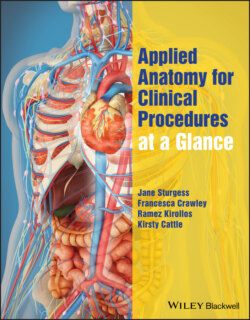Читать книгу Applied Anatomy for Clinical Procedures at a Glance - Jane Sturgess - Страница 2
Table of Contents
Оглавление1 Cover
2 Contributors
3 1 Scrubbing up Equipment (Figure 1.1) Antiseptic solutions Procedure (Figure 1.4)
4 2 Setting up a sterile field and draping the patient Equipment (Figure 2.1) Procedure Top tips
5 3 Three‐way tap Description of the three‐way tap Potential uses of the three‐way tap (Figure 3.3) Safe use of a three‐way tap After the procedure Anatomical pitfalls Top tips
6 4 Common equipment for core clinical procedures Needles Sampling devices
7 5 Local anaesthetic infiltration Classes of local anaesthetics (Figure 5.1) Mechanism of action Dose Side effects Technique Anatomical pitfalls Top tips
8 6 Obtaining consent Why do we obtain consent? Principles of obtaining consent if the patient has capacity Principles of obtaining consent if the patient does not have capacity Obtaining consent Responsibility for obtaining consent Discussing side effects/risk Verbal or written consent? (Figures 6.2 and 6.3) Consent in children
9 7 Manometer for central venous pressure and lumbar puncture What is a manometer line? What is normal pressure? Set‐up of the CSF manometer line Set‐up of the CVP manometer line Common anatomical pitfalls
10 8 Bladder irrigation sets Equipment Set‐up Common anatomical pitfalls Top tips
11 9 Underwater seal for chest drains Equipment (Figure 9.1) Connection (Figures 9.3 and 9.4) How does it work? (see Figure 9.2) Anatomical pitfalls Top tips
12 10 Male catheterisation Equipment (Figure 10.1) Procedure Contraindications Common problems
13 11 Female catheterisation Indications Equipment (Figure 11.1) Pre‐procedure Procedure Top tips
14 12 Arterial blood gases Equipment (Figure 12.1) Procedure Post‐procedure Allen’s test (Figure 12.3) Brachial and femoral stabs Common anatomical pitfalls Top tips
15 13 Performing an electrocardiogram Equipment (Figure 13.1) Procedure Anatomical (and other) pitfalls Top tips
16 14 Oropharyngeal airway Equipment (Figure 14.1) Technique (Figure 14.2) Aftercare Common anatomical pitfalls Top tips
17 15 Nasopharyngeal airway Equipment (Figure 15.1) Technique (Figure 15.2) Aftercare Common anatomical pitfalls Top tips
18 16 Laryngeal mask airway Equipment Technique Aftercare Common anatomical pitfalls Top tips
19 17 Central venous cannulation (high approach internal jugular) How to insert a central venous line Equipment (Figure 17.1) Technique (Figure 17.3) Landmarks for internal jugular vein (Figure 17.4) Aftercare Common complications
20 18 Central venous cannulation (low approach internal jugular) How to insert a central venous line Equipment (Figure 18.1) Technique (Figure 18.3) Landmarks for internal jugular vein (Figure 18.4) Aftercare Common complications
21 19 Central venous cannulation (subclavian) How to insert a central venous line Equipment (Figure 19.1) Technique (Figure 19.3) Aftercare Common complications Landmarks for subclavian vein (Figure 19.4) Top tips
22 20 Direct current cardioversion Indications Equipment (Figure 20.1) Contraindications Pre‐procedure Procedure Post‐procedure Top tip Pitfalls
23 21 Intercostal drains Requirements Equipment (Figure 21.1) Procedure – Seldinger technique Procedure – Surgical technique Anatomical (and other) pitfalls
24 22 Pleural tap Requirements Equipment (Figure 22.1) Procedure Anatomical (and other) pitfalls Complications
25 23 Inserting a nasogastric tube Equipment (Figure 23.1) Procedure Post‐procedure Contraindications to NGT insertion Pitfalls Top tips
26 24 Lumbar puncture Equipment (Figure 24.1) Technique Aftercare Common anatomical pitfalls Top tips
27 25 Bone marrow aspirate Equipment (Figure 25.1) Pre‐procedure Procedure Clotting requirements for a bone marrow aspirate
28 26 Ascitic tap Equipment (Figure 26.1) Contraindications Pre‐procedure Procedure Post‐procedure Top tips
29 27 Paracentesis Indications Equipment (Figure 27.1) Pre‐procedure Procedure Post‐procedure Complications
30 28 Knee aspiration Equipment (Figure 28.1) Indications Procedure Aftercare Common anatomical pitfalls (Figure 28.3) Anatomical top tips
31 29 Skin biopsy Equipment (Figure 29.1) Indications Procedure Anatomical pitfalls Top tips
32 30 Basic suturing Equipment (Figure 30.1) Choice of suture Factors determining the choice of sutures and needles Technique Variations in suturing techniques Removal of sutures Anatomical pitfalls
33 31 Basic anastomotic techniques Equipment (Figure 31.1a–c) Technique Types (Figure 31.2) Anatomical pitfalls: Bowel Anatomical pitfalls: Vascular Aftercare: Bowel Aftercare: Vascular
34 32 Abscess drainage and debridement Equipment (Figure 32.1) Procedure (Figure 32.2) Aftercare Pitfalls Anatomical top tips
35 33 Bag mask ventilation (adults) Equipment (Figure 33.1) Technique (Figure 33.2) Aftercare Common anatomical pitfalls Top tips
36 34 Endotracheal intubation (adults) Equipment (Figure 34.1) Technique Aftercare Common anatomical pitfalls Top tips
37 35 Needle cricothryoidotomy (adults) Equipment (Figure 35.1) Technique Aftercare Common anatomical pitfalls Top tips
38 36 Surgical cricothyroidotomy Equipment Indications Contraindications Procedure (Figure 36.2) Aftercare Common anatomical pitfalls Top tip
39 37 Defibrillation Equipment (Figure 37.1) Technique Aftercare Common anatomical pitfalls Top tips
40 38 Spinal injection Equipment (Figure 38.1) Technique Aftercare Common anatomical pitfalls Top tips Difficulty aspirating CSF Safety (Figure 38.5)
41 39 Epidural injection Equipment (Figure 39.1) Technique Aftercare Common anatomical pitfalls Top tips
42 40 Procedure‐related safety The problem Definitions (as per the World Health Organisation) The response Responsibilities for National Health Service (NHS) and staff Top tips (from the World Health Organisation) References Additional reading
43 Index
44 End User License Agreement
